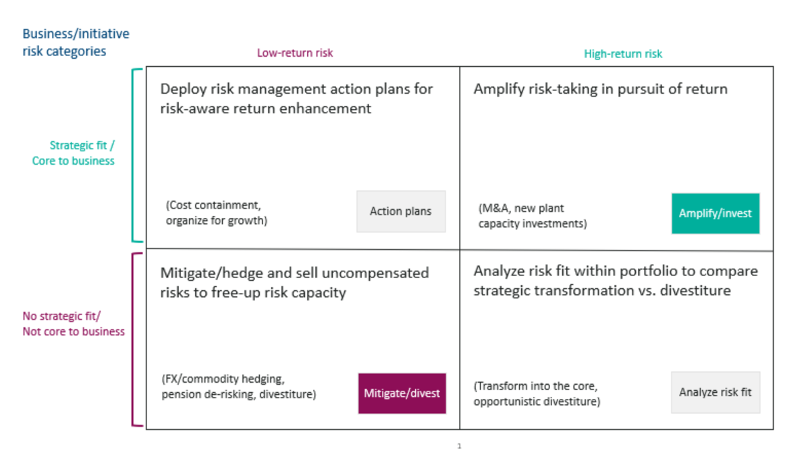
With the Ukraine war, supply chain disruptions, rising interest rates and strong dollar, companies face unprecedented worldwide volatility. This environment is accelerating the need for treasury professionals to think more broadly and strategically across their entire organizations through an enterprise risk management (ERM) lens. Gaining an understanding of treasury’s role in ERM can position treasury leaders to contribute a critical perspective to enterprise-level conversations about risk tolerance, assessment and mitigation.
The Next Phase of ERM
ERM is evolving into holistic risk management. This means identifying and assessing risks across an organization to eliminate unwanted risks and create room for smarter risk-taking on high-return strategic business initiatives.
Greg Deveney of Chatham Financial
Managing risk on a holistic level poses challenging questions:
- How do we assess how much aggregate risk-taking is prudent?
- What is our organization’s risk capacity?
- What if our risk tolerance requires a cash buffer for unexpected cash flow surprises?
The answers revolve around understanding an organization’s risk capacity and risk tolerance.
Assessing Risk
To apply ERM for treasury, your team must first quantify and analyze the risk inherent to your portion of the business. For example, can the team quantify risk related to interest rates, foreign exchange (FX), and commodity exposure? Understanding those risks and how you can best manage them is crucial to reducing volatility in the organization’s financials.
Although seemingly a straightforward process, many companies struggle to specify how much financial risk is on the books. This process requires a deep understanding of the underlying indices for loans, the full FX portfolio and all major supplier agreements. Then, you need the ability to model these risks and quantify them against a threshold.
Determining Risk Capacity
Every company will have a different threshold for risk. High-margin businesses may be able to weather significant downturns, while lower-margin businesses may need to take additional steps to reduce risk down to the minimum amounts. That’s why it’s important to have a consistent framework to talk about risk management across the organization.
Johan Nystedt of Nystedt Enterprise Solutions
Although many organizations talk about risks, it is often done in a siloed way, limiting the ability to think holistically. For example, risk is often viewed as something to be eliminated or avoided, as with insurance, derivatives, and IT security. This ignores the important risks companies choose to take to expand their impact, such as new markets, new product offerings and M&A.
Treasury can position itself as a key hub of risk communication, since many risks ultimately will arise in the financials. For example, risks that start in areas like accounting and procurement will ultimately impact treasury as well.
To maximize impact across the organization, your treasury organization should look beyond the most obvious financial risks. You must position risk management as an opportunity for other areas of the business to take more risks that may lead to higher-level returns. Additionally, you should seek to partner with other areas of the business to maximize impact.
For example, treasury and procurement can work together to clearly identify who is responsible for managing which risks and how. Chatham has seen cases where procurement had embedded FX derivative contracts into supplier agreements without making treasury aware, leading to unmanaged risk. Taking a broader, more holistic view is the only way to identify these risks.
Leading treasury professionals are positioning their teams at the forefront of creating risk appetite for other business areas, not just reducing risk on the financials. Using a matrix like the one below can help your organization correctly categorize risk and communicate decision-making across the organization. This framework is provided by Nystedt Enterprise Solutions LLC to manage its clients’ risk portfolios:

Over the past year, treasury leaders have demonstrated their teams’ value in protecting their organizations' margins by managing unprecedented volatility. Going forward into an uncertain market, they can leverage this seat at the table, working with senior stakeholders across the organization to develop a strategic, holistic approach to quantifying, assessing and managing risk through an ERM program.
Greg Deveney leads Chatham Financial’s corporate Treasury Advisory team where he works with international corporate clients, advising them on foreign currency and interest rate risk. He earned an MA in Mathematics from West Chester University and an MBA from Penn State.
Johan Nystedt is the founder and president of Nystedt Enterprise Solutions LLC. After having managed risk for companies including Conagra Brands (as the chief risk officer), Levi Strauss, RR Donnelley and Kraft Foods, he founded Nystedt Enterprise Solutions, where he can be contacted at +1 630-570-0499 or johan.nystedt@nystedtsolutions.com.
Topics: Enterprise